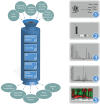Mass spectrometry-based proteomics in cell biology
- PMID: 20733050
- PMCID: PMC2928005
- DOI: 10.1083/jcb.201004052
Mass spectrometry-based proteomics in cell biology
Abstract
The global analysis of protein composition, modifications, and dynamics are important goals in cell biology. Mass spectrometry (MS)-based proteomics has matured into an attractive technology for this purpose. Particularly, high resolution MS methods have been extremely successful for quantitative analysis of cellular and organellar proteomes. Rapid advances in all areas of the proteomic workflow, including sample preparation, MS, and computational analysis, should make the technology more easily available to a broad community and turn it into a staple methodology for cell biologists.
Figures




References
Publication types
MeSH terms
Substances
LinkOut - more resources
Full Text Sources
Other Literature Sources

